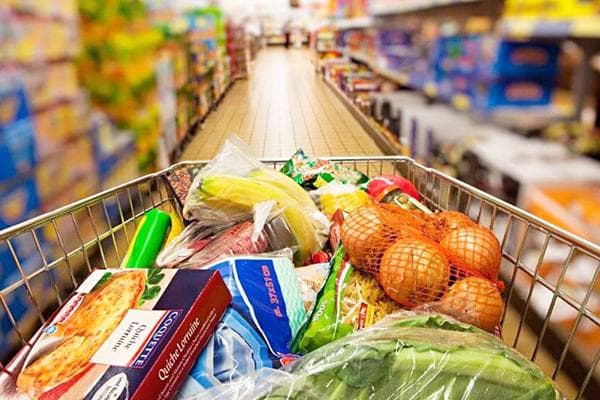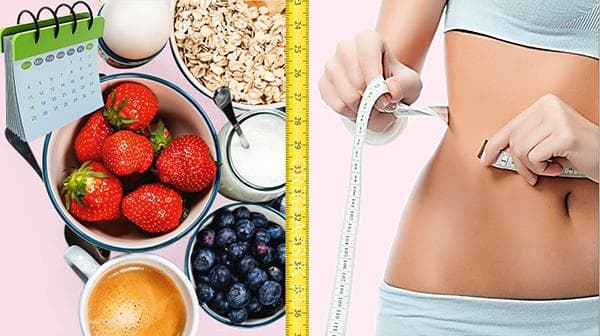A rational list of products and a menu of them: for variety, health and budget savings
Content:
If you develop the habit of making a grocery list for the week, you will save the lion's share of your family budget. And you don’t have to run to the store every day to buy the missing ingredients. It’s better to create a list in parallel with creating a menu. At the same time, you can set useful goals for yourself: feed a large family, please your child, diversify your diet, or lose weight.

List of necessary products for the week
In this section, we will consider options for a tasty, varied and balanced menu for the whole family. If you regularly consume the suggested dishes, you will notice positive changes in your health and appearance within a month.
Weekly grocery list for 2 people
For 2 adults you won’t need to buy a lot of groceries. The menu should definitely include vegetables and fruits, meat, fish, cereals, and vegetable oils. The remaining ingredients are up to your taste.
Table 1.Sample menu for 7 days for a family of 2 people
| Eating | Food options |
|---|---|
| Breakfast | 1. Omelette of 2 eggs with tomatoes. |
| 2. Muesli with kefir. | |
| 3. Oatmeal pudding with yogurt. | |
| 4. Buckwheat porridge with butter. | |
| 5. Pancakes with cottage cheese and raisins. | |
| 6. Smoothie made with drinking yogurt with banana and apple. | |
| 7. Sandwiches with soft cheese, salmon and herbs. | |
| Lunches | 1. Beef borscht + buckwheat porridge + chicken cutlets. |
| 2. Baked potatoes + tomato and herb salad. | |
| 3. Beef steak + salad of leafy vegetables with tomatoes. | |
| 4. Fresh cabbage soup with pieces of chicken + a sandwich made of whole grain bread with soft cheese and herbs. | |
| 5. Draniki with onions and sour cream. | |
| 6. Pasta with minced beef and tomato sauce. | |
| 7. Beef goulash + mashed potatoes. | |
| Snacks | Oranges, apples, bananas, kefir, walnuts, prunes, dark chocolate. |
| Dinners | 1. Omelette of 2 eggs. |
| 2. Grilled chicken fillet + salad with fresh cucumbers and tomatoes. | |
| 3. Baked white fish with lemon juice + vegetable salad. | |
| 4. Boiled brown rice with paprika. | |
| 5. Cottage cheese with cinnamon. | |
| 6. A glass of kefir + 2 whole grain toasts with salmon and soft cheese. | |
| 7. Boiled pollock + sliced fresh cucumbers. |
If you analyze the diet described in the table, you can make approximately the following list of necessary products:
- eggs - a dozen;
- tomatoes – 1–1.5 kg;
- cucumbers – 0.8–1 kg;
- potatoes – 1.5–2 kg;
- white cabbage – 1 head;
- leafy vegetables – 200 g;
- onions – 2 pcs.;
- bananas – 4 pcs.;
- apples – 4 pcs.;
- oranges – 2 pcs.;
- lemon – 1 pc.;
- fresh herbs - a bunch;
- oatmeal - a pack;
- buckwheat - a pack;
- muesli - a pack;
- brown rice - pack;
- whole grain bread – 500 g;
- pasta – 500 g;
- drinking yoghurt – 3–4 jars of 0.5 l;
- kefir – 2 packets of 1 liter;
- butter – 100 g;
- milk – 1 l;
- soft cheese – 300 g;
- cottage cheese – 3 packs of 200 g;
- sour cream – 200 g;
- raisins – 30 g;
- prunes – 30 g;
- walnuts – 70 g;
- lightly salted salmon fillet – 200 g;
- beef – 1 kg;
- chicken fillet – 1.5 kg;
- pollock or hake – 1 kg;
- tomato sauce – 300 g;
- dark chocolate – 100 g;
- ground spices: “Italian herbs”, paprika, cinnamon;
- vegetable oil - bottle.
Many of the ingredients listed will remain with you for the next week. For example, cereals, seasonings, oil.
Grocery list for a week with a child
If you live with a small child, you should include dishes on the menu that will be not only healthy, but also tasty.
The following meal options are ideal for children aged 1 to 6 years:
- milk porridge;
- fruit salads;
- meat soufflé;
- meatballs;
- dumplings with berries or cottage cheese;
- vegetable casseroles.
Therefore, the emphasis in the list should be on milk and dairy products, flour, low-allergenic fruits (apples, pears, bananas, zucchini, potatoes), and chicken. You can also pamper children with healthy sweets: oatmeal cookies, halva, marmalade and marshmallows.
List of products for allotment - “economy” options
Not every family can afford to buy expensive goods: nuts, dried fruits, red fish, beef, sweets. Is it possible to come up with a menu of the right, tasty, but budget products? Fortunately, such options can be found if you use your imagination.
List of products for a week for 1000 rubles
To look for economical products, go to grocery discounters (for example, Pobeda, Svetofor, Da!, Economy, Magnit, Pyaterochka).Inexpensive vegetables and fruits can be bought at markets. Avoid processed foods and try to cook your own meals.
We offer you an approximate list of inexpensive products worth 1000 rubles:
- chicken eggs, 2 dozen – 130 rubles;
- chicken carcass, 1.5 kg – 260 rubles;
- cottage cheese, 0.5 kg – 150 rub.;
- flour, 2 kg – 70 rub.;
- pasta, 1 kg – 40 rubles;
- sugar, 1 kg – 30 rubles;
- potatoes, 2 kg – 50 rub.;
- buckwheat, 1 kg – 60 rubles;
- white rice, 1 kg – 70 rub.;
- Sunflower oil, 1 l – 80 rub.;
- white cabbage, 1 kg – 30 rubles;
- carrots, 1 kg – 30 rub.
With such a food basket, you can prepare only simple dishes for breakfast and lunch: pancakes, cheesecakes, porridge, baked potatoes. For dinner you can eat chicken + carrot and cabbage salad or omelet.
Weekly grocery list for a large family
For a large family, the above list will seem meager. But you can create a more varied menu using inexpensive ingredients.
For 4–6 people (including a family with a child), the following food basket is suitable:
- eggs, 20 pieces – 130 rubles;
- chicken breast, 1.5 kg – 210 rubles;
- white fish, 1 kg – 200 rubles;
- bread, 1 pc. – 30 rub.;
- hard cheese, 300 g – 150 rubles;
- milk, 2 l – 50 rub.;
- apples, 1 kg – 60 rubles;
- bananas, 1 kg – 70 rubles;
- buckwheat, 2 kg – 120 rubles;
- white rice, 2 kg – 140 rubles;
- oat flakes, 0.5 kg – 110 rubles;
- pasta, 1 kg – 40 rubles;
- potatoes, 3 kg – 75 rubles;
- white cabbage, 2 kg – 60 rubles;
- carrots, 2 kg – 60 rubles;
- tomatoes, 1 kg – 200 rubles;
- sugar, 1.5 kg – 45 rubles;
- flour, 2 kg – 70 rub.;
- vegetable oil, 1 l – 80 rub.;
- frozen vegetable mixture, 1 kg – 100 rub.
It turned out to be 2000 rubles. This amount still fits into the budget of a family with a lower average income.The morning menu can include sandwiches with cheese, an omelette with tomatoes, and oatmeal with milk. And for one of the dinners, treat your family members to grilled fish or chicken chops.
Weekly grocery list for weight loss
The basis of a diet for weight loss should be low-calorie foods rich in vitamins, macro- and microelements. You can save most of your budget on sweets and fast food.
We suggest you make the following list of products (for 1 person) for 7 days:
- oatmeal or muesli – 0.5 kg;
- brown rice – 0.5 kg;
- buckwheat – 0.5 kg;
- whole grain bread – 0.5 kg;
- chicken eggs - a dozen;
- chicken breast – 1.5 kg;
- white fish – 1 kg;
- soft cheese – 250 g;
- kefir 2.5% – 1 l;
- cottage cheese 5% – 2 packs of 200 g;
- unsweetened drinking yogurt – 2 jars of 0.5 l;
- tomatoes – 1 kg;
- cucumbers – 1 kg;
- one lemon;
- oranges – 1 kg;
- pineapple – 1 pc.;
- apples – 0.5 kg;
- bell pepper – 0.5 kg;
- carrots – 0.5 kg;
- fresh herbs - 2 bunches;
- frozen broccoli – 0.5 kg;
- frozen green beans – 300-400 g;
- frozen berries (for example, blueberries) – 400 g;
- Extra Virgin olive oil or flaxseed oil – 0.5 l;
- durum wheat spaghetti – 500 g;
- walnuts or hazelnuts – 100 g;
- pumpkin seeds – 100 g.
It is better to bake chicken and fish in the oven or on the grill, vegetables - eat fresh or stew. It is advisable to consume porridge, pasta, nuts and seeds in the first half of the day. Vegetable salads, berries and kefir - at any time of the day.
Weekly grocery list for vegetarian menu
Since the vegetarian menu does not include meat and fish, when forming a food basket, it is important to select other complete sources of protein. And also look for foods rich in vitamin B12 and iron. It is the deficiency of these substances that is often observed in vegetarians.
We offer you the following set of products:
- Cereals: oatmeal, barley, millet, buckwheat – 1 kg each.
- Vegetables: 1 kg of tomatoes, cucumbers and carrots, 0.5 kg of bell peppers and beets, 1.5–2 kg of potatoes, 8–10 radishes, 1 head of Chinese cabbage, 1 bunch of arugula and cilantro, 4 stalks of celery, 2 avocados, 5 zucchini, 5 heads of garlic.
- Fruits: 1 kg of oranges, 3 bananas, 1 kg of apples, 2 lemons, 0.5 kg of grapes.
- Greens - 3 bunches (for example, dill, parsley and spinach).
- Legumes - 1 kg of beans, peas and lentils, 200 g of peanuts.
- Nuts: 100 g each of hazelnuts, cashews and walnuts.
- Canned corn, green peas and white beans - 2 cans of each product.
- Spices: 1 bag each of black pepper, chili, paprika, cinnamon, rosemary, oregano, turmeric, cumin, bay leaf.
- Sugar – 1 kg.
- Flour – 1 kg. + baking powder.
- Olive oil – 0.5 l.
Many components (cereals, legumes) will last for another 2-3 weeks. Lacto-ovo vegetarians can additionally purchase 1 liter of milk and kefir, 300-400 g of hard cheese.
How to make a grocery list for 2 weeks or a month?
If you're shopping for long-term supplies, check out the grocery store. Take 1 kg of main cereals (buckwheat, rice, oatmeal, pearl barley) and legumes (beans, peas). Buy sugar, salt, vegetable oil, and your favorite spices.
You can grab canned food: 1-2 cans of corn, peas, beans, olives, stewed meat. From the frozen food section, grab 1-2 kg of mixed vegetables. But it’s better not to buy sweets 14 days in advance, as they are quickly eaten.
Planning your purchases is the best way to save your health, time and some money in your wallet. Don't be lazy about making lists. Moreover, now you can download many special applications to your phone or PC that make the task easier. And the information from the article will become your first guide.




At 1000
Great lists. I'll definitely use it